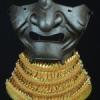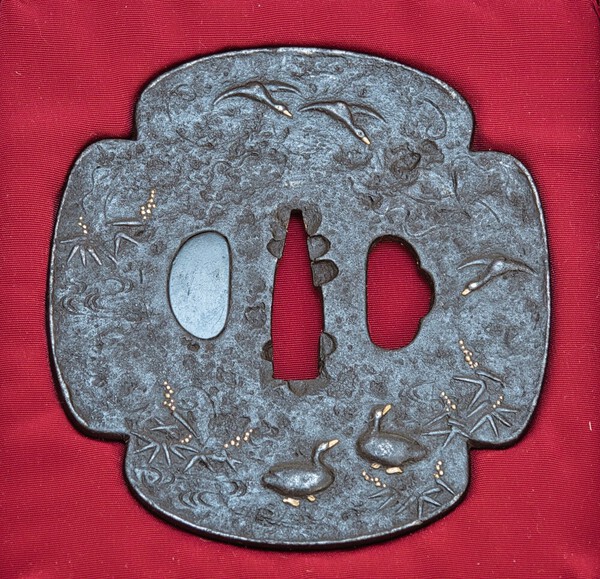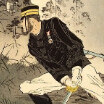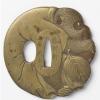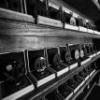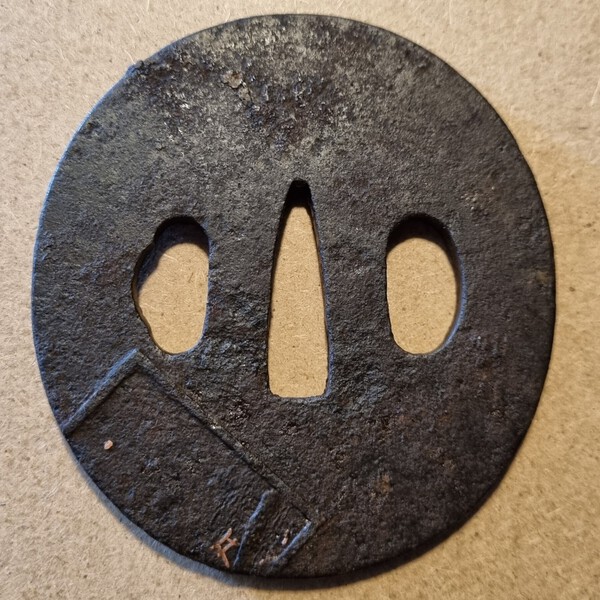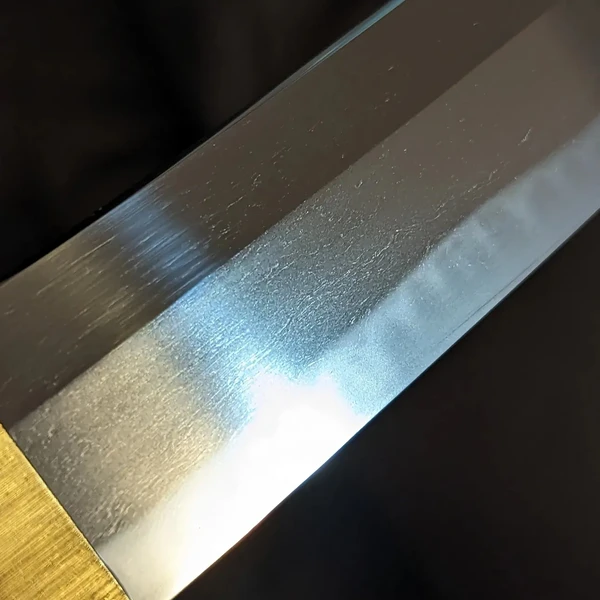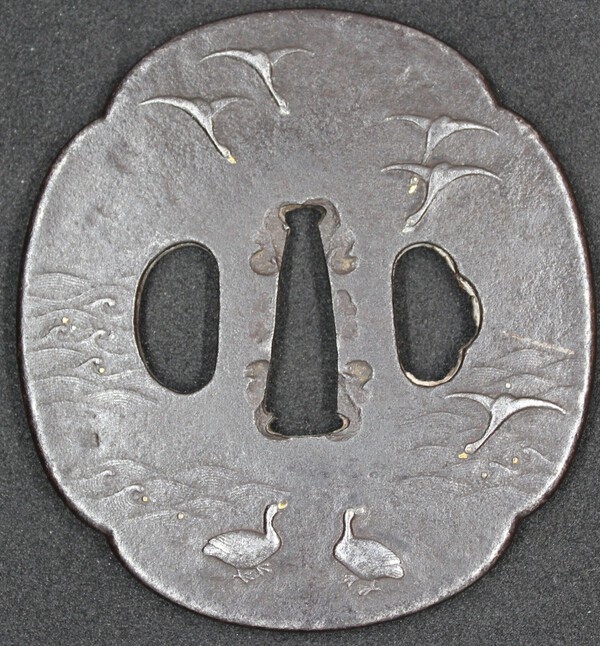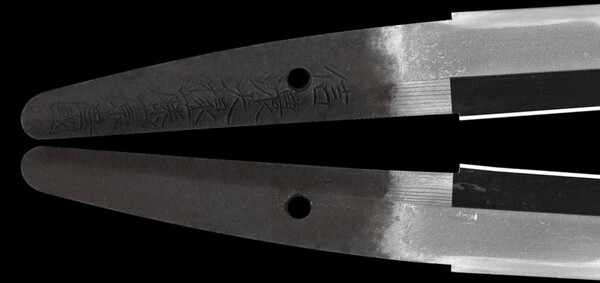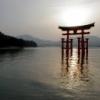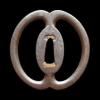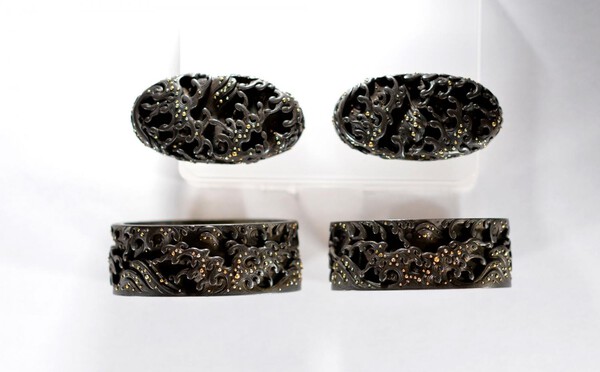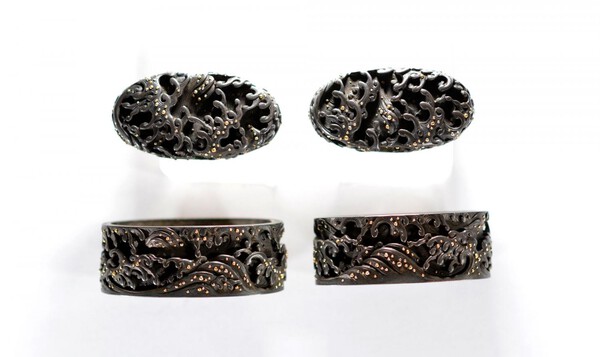Leaderboard
Popular Content
Showing content with the highest reputation on 10/11/2023 in all areas
-
This samurai is holding a lantern. According to the mon(s) depicted on his trousers, it can be one of the 47 ronins (chusingura).....!4 points
-
3 points
-
Absolutely not, they will very likely disintegrate or have the dyes run/discolour. They are made of silk and any care or maintenance should follow silk care guides.3 points
-
3 points
-
It was used to illuminate in one direction like a flashlight. the interior was made to reflect light.3 points
-
3 points
-
If you are looking for more in-depth on a specific smith, I recommend the articles on Nihonto.com... -t2 points
-
2 points
-
2 points
-
2 points
-
The patched ball, of course, is first associated with a muzzleloading rifle. However, the 'Westerners' (Europeans, Americans) also used it in smoothbore guns. This slowed down loading but noticeably improved accuracy. The use of patched roundballs by light infantry armed with smoothbores (tirailleurs, jägers, etc.) is mentioned in military literature. Everything indicates that it was also used in smoothbores by hunters, as evidenced by archaeological finds. For non-shooters, let me briefly recall the reasons for the inaccuracy of smoothbore weapons. The ball has the so-called wintage, i.e. its diameter is smaller than the caliber of the bore. As a result, while moving in the bore, the bullet randomly hits the bore walls, which gives a double effect. 1. The ball leaves the bore along a line that does not coincide with the bore axis. 2. The ball rotates around an axis transverse to the trajectory, which - due to the Magnus effect - causes a (approximately) parabolic bending of the trajectory (like volleybal topspin). The intensity and vector of both phenomena is random, but their effects add up. The patch virtually eliminates it, not to mention better use of powder gases. If the ball is round enough, it will fly more accurately, especially over a longer distance. Where accuracy was more important than rate of fire, the 'Westerners' could use rifles. The Japanese only had smoothbores, but I suppose they may have been interested in achieving maximum accuracy in many situations. In this case, patched ball would be a simple and even obvious solution. In a pitched battle (close formation, stress, fear, clouds of smoke covering the target) what mattered was the rate of fire and I think that in Japan the situation was no different from Europe. However, during a siege or hunting trip, for example, accuracy could be more important and there was enough time to allow for careful loading. Was Takeda Shingen's wounding at Noda Castle a result of chance or meticulous gun handling? That's why I'm asking if there is any information in Japanese sources, e.g. shooting school manuals, about the use of patched roundballs in teppo? The illustrations suggest that great attention was paid to aiming, but were measures recommended to reduce ball dispersion?1 point
-
1 point
-
Hello everyone ! Just wanted to share with you a project we are working on from Japan. A 80cm blade Tachi with a Koshirae for one of our customer who wants to practice tameshigiri. The customer gave us a lot of freedom on the details and style so it will be very satisfying to make realise this project. The Tachi will have a long leather handle, silver heavy tsuba and silver fittings. Can't wait to share with you guys more on this sword and show you pictures when the sword is finished ! We're also currently working on an even more crazy project that might have never been done before, let me know if you're interested to see.1 point
-
Could anyone help me please with the significance (if any) of this kozuka? It appears to be a tethered hawk on a perch atop a decorated stand above a recumbent ferocious-looking shishi. The lengthy tether has many loops and tassels at the end. I thought it was an eagle at first - but a little research revealed that hawking/falconry was popular with samurai in Japan and are often depicted on a perch with a tether in paintings and prints. The hawk was considered a symbol of endurance and status, while the shishi, of course, is a symbol of strength, courage and protection. I couldn't find anything relating to a shishi being depicted with a hawk and whether the end of the stand actually is thrust into the shishi is hard to decide. It may simply be two favourite symbols used together to signify that the kozuka belonged to a brave elite samurai! I think the metal is perhaps sentoku or shinchu and there are copper highlights on the hawk, shishi, decoration and cords. If anyone has any ideas I'd be pleased to hear them. Thanks and regards David1 point
-
1 point
-
Dear Colin. A lovely thing! Just for interest there are some fight manuals which illustrate fighting with sword and lantern, the light to blind the eyes of the opponent or at least rob them of night vision. https://elegant-weap...logspot.com/2015/09/ From memory there was a duel using such in one of the Musketeer films featuring Michael York. All the best.1 point
-
Wow could he afford so much gold? [Are you sure it isn't a crumb left over from a biscuit? ] Hey I thought the moon was supposed to be silver! Whatever happened to the good old days when the moon was made of cheese - [never been a fan of green cheese, let alone grey cheese!]1 point
-
I bought this little tanto two months ago - it only arrived today - gave it a quick clean and discovered under the dirt and rust a hidden little silver Moon breaking through the clouds. It was just another blob on the auction images, though the focus is a lot better than my cheap camera can manage! This tanto guard of mine is 55 mm in height and I estimate the moon is a little over 2 mm across. Phil Fellman has posted two larger guards back on the 16th of September, which look very small as well. So a question - what is the smallest moon we have seen on a tsuba?1 point
-
Thank you, Bruno! Apart from the metals, the kozuka depicted is virtually identical to mine and the information provided is similar to my own thoughts. Much appreciated! Regards David1 point
-
1 point
-
I do believe Piers has one of these gimbal lanterns and there is an illustration of how it works somewhere on NMB in his excellent Edo Period Corner articles.1 point
-
Theories are proven OR disproven. Search for evidence and let that guide you. Just in general, many investigators run into trouble trying to "find" evidence that proves their theory. Remember too, that disproving and eliminating a theory is just as important, since you would no longer waste time researching it. IMHO, John C.1 point
-
1 point
-
First got my hands on my first nihonto, all thanks to Nick over at Nihontoart.com. Nick is a definitely trustworthy seller who answered all of my questions. He was quick with sending my item and even gave me a cleaning kit for free. I haven’t had the chance to take good photos of my Odachi but here is the link to it. https://nihontoart.c...original-edo-mounts/ it is definitely an amazing feeling to get my first nihonto.1 point
-
Definitely an older sword mounted for the war. Could easily (and probably) be an antique. Remember that during the war, the authorities purchased thousands of old mediocre blades to be remounted for the war effort. Also dealers would take orders using old blades and mounting them in Shin Gunto fittings, or even partial civilian fitting which this one has. Double habaki leads to an old sword most likely. It's a mixture of parts, mostly civilian, so likely an old sword taken to war, or even just an antique civilian sword taken during the war. Once you remove the handle and we can see the tsuba and nakago, we can tell more.1 point
-
I think I cannot handle such a long katana. How to draw a long katana: (Watch from 2:30 - ) (1) #39【長い刀の抜き方】日本刀専門店 銀座長州屋 - YouTube1 point
-
I'm looking forward to attending the Dai Token Ichi this year for the very first time. Thank you, Robert, for putting together the DTI additional events. My wife Tamaki-san also wants to attend the Yakatabune Tokyo Bay Cruise on Saturday, November 18. I'm very much looking forward to November.1 point
-
1 point
-
Ah, thanks! "Japanese his name is written 不動明王. It literally means “The immovable wisdom king”. He is the guardian of Buddhism and one of the five Wisdom kings along with Gōzanze, Gundari, Daiitoku and Kongōyasha" Good luck with the sale!1 point
-
1 point
-
1 point
This leaderboard is set to Johannesburg/GMT+02:00

